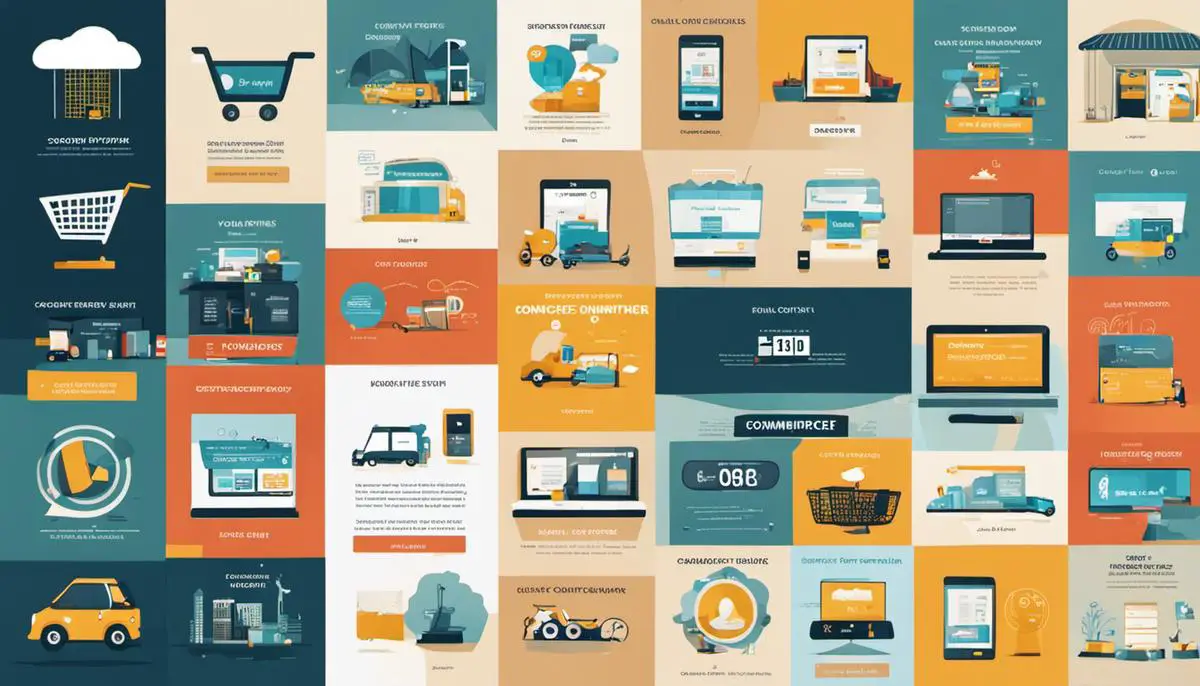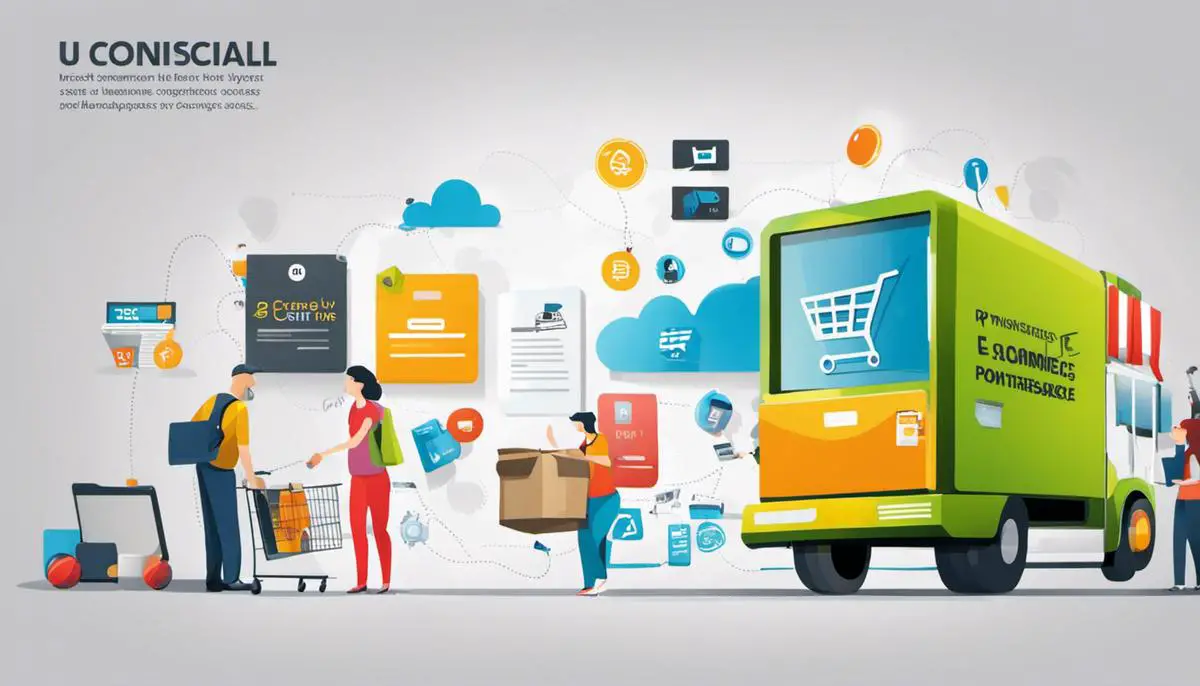As we journey further into the age of digital technology, e-commerce stands out as a significant touchstone in the transformation of global economic trends. With growing accessibility to the internet and mobile devices, the possibilities for entrepreneurial endeavors in e-commerce are expanding every day. For young adults eager to carve their own path in this realm, understanding its nuances is crucial. This piece will take you through the foundational understanding of e-commerce, provide insights into the variety of business models and strategies at play, and finally equip you with a practical guide to launching your own e-commerce venture.
Understanding E-commerce
Understanding E-Commerce: The Basics
E-commerce, short for electronic commerce, is the act of buying or selling products or services over the internet. The origins of e-commerce can be traced back to the 1960s with the rise of electronic data interchange and teleshopping, but it truly took off with the dissemination of the internet in the 1990s and 2000s.
Currently, e-commerce is ubiquitous thanks to technological advances, improved internet connectivity, and the proliferation of smartphones. From everyday household items to luxury purchases, e-commerce platforms offer an assortment of products catering to all strata of consumers.
Types of E-Commerce Businesses
Regularly, the different types of e-commerce are classified based on the nature of the transactions. For instance, B2C or Business-to-Consumer is the most commonly known type where businesses sell to consumers. Popular platforms like Amazon and eBay operate under this model.
Business-to-Business or B2B is another type, where one business sells to another. Large scale transactions often happen in this format. Alibaba is a good example of a B2B platform.
Consumer-to-Consumer (C2C) is a type where consumers directly buy from other consumers. This is often facilitated by third-party platforms like Craigslist or eBay.
Evolution of E-Commerce: Wholesale, Retail, Digital Products
With time, e-commerce has morphed to sell not just physical items, but digital products as well. These include e-books, music, video content, software, or digital subscriptions.
Retail and wholesale e-commerce varies in terms of scale and customer base. Retail e-commerce involves businesses selling directly to consumers. It is the equivalent of an online store.
Wholesale e-commerce, on the other hand, involves transactions between businesses. For instance, a manufacturer might sell large quantities of a product to a retailer, who then sells the product to consumers.
Advantages of E-Commerce
E-commerce offers numerous benefits. For entrepreneurs, it provides a platform that needs minimal startup costs compared to a traditional brick-and-mortar store. It also allows for a wider customer base beyond geographical barriers.
From a consumer standpoint, it provides convenience, as one can shop from the comfort of their own home. Also, the ability to compare prices, view reviews and ratings before purchase are added benefits.
Disadvantages of E-Commerce
However, e-commerce does have its downsides too! For retailers, competition is fierce, customer loyalty is hard to maintain, and technical glitches can impact business.
For consumers, concerns revolve around the lack of personal service, the inability to inspect products physically before purchase, and worries about online security.
Demystifying E-Commerce for Young Adults
With intent to navigate the digital age successfully, young adults need to develop a deep understanding of the dynamics of e-commerce. Being educated about various e-commerce concepts, their potential and their challenges will enable the making of informed decisions, which plays a critical role in driving a successful e-commerce venture.

E-commerce Business Models and Strategies
An Introduction to Dropshipping: A promising e-commerce model
One effective e-commerce model that has been of significant interest to young adults and aspiring entrepreneurs, particularly those with limitation in funding or storage space, is Dropshipping. The mechanism is rather straightforward – you create an online store to retail the products of others, forwarding purchase orders to the actual product owner or manufacturer for fulfilment. Essentially, you act as the middleman, profiting from the price difference between wholesale and retail.
One of the major success stories of dropshipping is Wayfair, a company that astonishingly recorded a net revenue of $4.7 billion in 2017 by utilizing this model. The company’s strategy hinged on offering a vast array of home goods from various suppliers globally, thereby providing customers with extensive choices and simultaneously doing away with the need for physical storage.
Affiliate Marketing: Earning through Recommendations
Affiliate marketing is another widely used business model in the e-commerce industry. This involves promoting someone else’s products or services on your platform (such as a blog or social media page) and earning a commission for every sale made through your referral link.
Amazon is an excellent example of this, boasting a successful affiliate program known as Amazon Associates. This program has allowed countless businesses and individuals to earn income by promoting millions of new and used products from Amazon.com and its subsidiaries.
White Labeling: Selling Under Your Own Brand
White labeling is an e-commerce business model where you purchase a product from a manufacturer and sell it under your own brand. This allows businesses to offer products without having to engage in the process of designing, testing, and manufacturing new items.
Numerous businesses have thrived using this model, such as The Dollar Shave Club. The plan involved buying razors from a South Korean manufacturer, white-labeling them, and selling them on a subscription basis in the US. The reasonable pricing and diligent marketing efforts catapulted them to fame, resulting in a billion-dollar acquisition by Unilever in 2016.
Retail Arbitrage: Profit from Price Differences
Retail arbitrage is the practice of buying products from a retail store and then selling them online at a higher price. This model capitalizes on the price differences between different marketplaces.
An example of a successful retail arbitrage operation is Bookfinder.com. This website sources books from multiple online retailers, giving customers the opportunity to find the cheapest option or sell their own books at an advantageous price.
Dive into Reliable Profits with Subscription E-commerce Business
Subscription-based e-commerce is a fast-expanding business model that ensures consistent revenue flows while fostering durable customer relationships. The key to its success is the convenience it offers to customers, providing them with regular product or service deliveries without the hassle of repurchasing.
A quintessential example of this model’s effectiveness is the online streaming giant, Netflix. Starting as a monthly DVD-by-mail service, Netflix has skillfully evolved into an esteemed streaming platform, even producing its own content. With an impressive count of 208 million paid subscriptions during the first quarter of 2021, Netflix exhibits the substantial potential and scalability of a subscription-based e-commerce business model.

Starting an E-commerce Business
Choosing Your E-commerce Product or Service
When venturing into the e-commerce business, it’s paramount to thoughtfully decide on the product or service you intend to sell. Market demand, personal interests, and your set of skills should all play a significant role in the selection process. In the case of an already flooded market, your success largely pivots on your ability to make your product or service stand out distinctively. Aligning your product or service with your personal interests can fuel you with the passion needed for the hard work and dedication that goes into a thriving business. Finally, reflect on your skills as they can guide you towards a product or service you can proficiently deliver with consistent quality.
Establishing Your Online Store
Once you’ve chosen your product or service, the next step is building an online store. While you could sell on platforms like Amazon, having your dedicated e-commerce website provides more freedom and credibility. Set up your website with an easy to navigate user interface. You’ll want to have high-quality photos, detailed product descriptions, and a secure, convenient payment system. Choosing a reliable e-commerce platform like Shopify, WooCommerce, or BigCommerce is also crucial as they provide essential tools for inventory management, shipping settings, and customer relationship management.
Managing Operations and Customer Service
After getting your online store up and running, you’ll need to efficiently manage operations. This involves sourcing or manufacturing your product, inventory management, packaging, delivery, and returns. At each step, look for ways to streamline your operations to serve your customers better and maximize profits. Prioritize excellent customer service, which includes responding promptly and politely to customer inquiries and complaints, as this can greatly influence your business reputation.
Marketing and Advertising
Visibility is key in e-commerce, so you’ll need to establish a solid marketing strategy. This typically includes search engine optimization (SEO) to make your store more visible in online search results, as well as email marketing. Social media is an incredibly powerful tool for e-commerce businesses, allowing you to engage with your customers and reach new ones. Consider paid advertising options like Google AdWords and Facebook ads for higher visibility.
Managing your Finances
Keeping track of finances is vital in any business. Implement accounting systems that track your revenues, costs, and profitability. This can help you identify successful aspects of your business and areas for improvement. You may want to consult with an accounting professional for advice on handling taxes and regulatory requirements.
Navigating Legal Requirements
It’s crucial to understand the legal requirements for running an e-commerce business, which vary by country and state. These may include obtaining business licenses and permits, privacy regulations, tax obligations, and rules around customer data and marketing. It’s advisable to consult a legal professional with experience in e-commerce.
Drafting a Business Plan
A well-crafted business plan is essential when starting your e-commerce business. It serves as your roadmap, outlining your goals, strategies, target market, competitive analysis, marketing plan, and financial forecasts. Having a solid plan helps guide your decisions and impresses potential investors.
Overall, starting an eCommerce business involves a lot of planning, time, effort, and dedication. However, with the right product or service, a well-built online store, effective operations and customer service, a strong marketing strategy, solid financial management, an understanding of legal requirements, and a detailed business plan, you can create a successful online business.

After navigating this comprehensive journey through e-commerce’s intricate labyrinth, it’s evident that the potential for innovation and entrepreneurship in this arena is not just immense but also constantly evolving. Equipped with a foundational understanding of e-commerce, the knowledge of various business models, and a practical means to start your own e-commerce business, you are now ready to step into this dynamic world. Go forth and create your own digital market spot, harnessing the power of e-commerce and transforming innovative ideas into successful business ventures. Imagine, create, innovate, and remember, in the landscape of e-commerce, the world is your marketplace.




